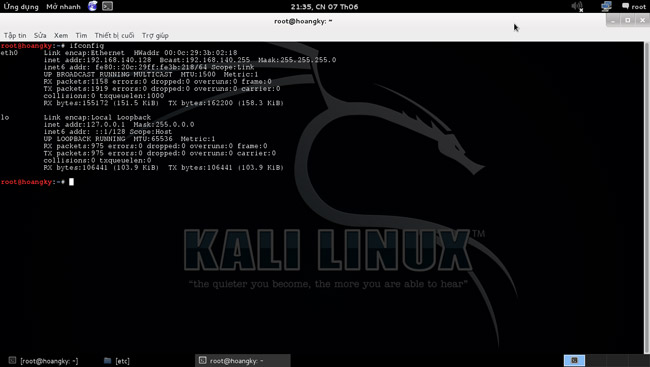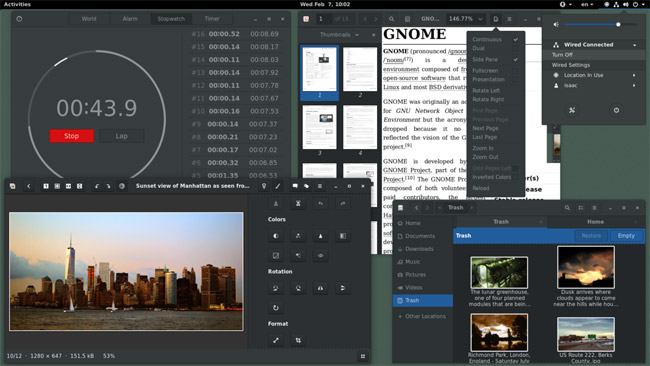Introducing Kali Linux operating system
Kali Linux is a Debian-based Linux distribution aimed at penetration testing and advanced security testing.
About Kali Linux
Potassium contains hundreds of tools aimed at various information security tasks, such as Penetration Testing, Security research, Computer Forensics and Reverse Engineering. Kali Linux is developed, funded and maintained by Offensive Security, a leading information security training company.
Kali Linux was released on March 13, 2013 as a complete reconstruction from BackTrack Linux, fully respecting Debian development standards.

Debian development standards
More than 600 penetration testing tools
After reviewing all the tools included in BackTrack, the Kali Linux team removed a large number of simple, inactive or duplicated tools with other tools, providing the same functionality. . Details of readers can be found on Kali Tools website (https://tools.kali.org/).
It's free and always like that
Kali Linux, like BackTrack, is completely free and will always be. You will never have to pay to use Kali Linux.
Open source Git system
Linux is committed to an open source development model that will be available to everyone. All source code in Kali Linux welcomes anyone who wants to tweak or rebuild packages to suit their individual needs.
FHS compliance
Potassium complies with the File System Hierarchy Standard, allowing Linux users to easily locate binary files, support files, libraries, etc.
Support a variety of wireless devices
Frequent attachment points with Linux distributions have been supported for wireless interfaces. The team built Kali Linux to support as many wireless devices as possible, allowing it to work well on a variety of hardware and make it compatible with many different wireless and USB devices.
Custom kernel, continuously updated to prevent virus infection
As a penetration testing tool, the development team often needs to perform reviews on wireless devices, so Kali Linux's kernel should be included in the latest fixes to ensure security. all.

Develop in a safe environment
The Kali Linux team is made up of a small group of trusted individuals who commit to packages and interactions with repositories - all done with multiple security protocols.
GPG has registered packages and archives
Each package in Kali Linux is registered by the individual developer - who built and committed it. Later, the archive also registered the packages.
Multi-language support
Although penetration tools tend to write in English, the Kali Linux team ensures that Kali has true multilingual support, allowing many users to operate in their native language and identify Essential tools for work.
Fully customizable
The development team fully understands that not everyone agrees with their design decisions, so the team has made it easier for users to customize Kali Linux to their liking.
Support ARMEL and ARMHF
Because single circuit board systems are based on ARM like Raspberry Pi and BeagleBone Black is becoming more popular and prices are also cheaper, the development team knows that Kali's ARM support will need to be robust to manage with installers. Set appropriate working for both ARMEL and ARMHF systems. Kali Linux is available on a variety of ARM devices and has an integrated ARM repository so the ARM tools are updated along with the rest of the distribution. Kali Linux is specifically designed for the needs of penetration testing experts.
See more:
- Instructions for installing Kali Linux on Windows 10 are easier than ever
- Kali Linux commands from AZ and commonly used commands
- Things you need to know about Kali Linux Image
You should read it
- How to update Kali Linux and fix errors when updating
- How to install Kali Linux on your computer
- How to install Kali Linux on macOS
- Instructions for installing Kali Linux on Windows 10 are easier than ever
- How to install Kali Linux dual boot on macOS
- How to create customized Potassium ISO
- How to create USB Boot Live Kali Linux
- Learn Forensics Mode in Kali Linux
May be interested
- How to install Kali Linux reduced version
 kali mini iso or kali linux's shortened version is a convenient way to install a minimal potassium system and install it 'from scratch'.
kali mini iso or kali linux's shortened version is a convenient way to install a minimal potassium system and install it 'from scratch'. - Kali Linux commands from AZ and commonly used commands
 combining kali linux commands from az comes with some commonly used kali linux commands that make it easy to work with this operating system.
combining kali linux commands from az comes with some commonly used kali linux commands that make it easy to work with this operating system. - Kali Linux is available on the Windows Store but is flagged by Windows Defender
 kali linux is available on windows 10 store for use with windows subsystem for linux, but it cannot bypass windows defender.
kali linux is available on windows 10 store for use with windows subsystem for linux, but it cannot bypass windows defender. - How to install Kali Linux on macOS
 since the release of kali linux 1.0.8, kali linux supports efi. this additional feature simplifies the process of installing and running potassium on various apple macbook air, pro and retina models.
since the release of kali linux 1.0.8, kali linux supports efi. this additional feature simplifies the process of installing and running potassium on various apple macbook air, pro and retina models. - Team Kali Linux teaches free online pentest on Twitch
 offensive security, the creators of kali linux, has just announced that they will host a free penetration testing (pentest) course with kali linux.
offensive security, the creators of kali linux, has just announced that they will host a free penetration testing (pentest) course with kali linux. - How to install Kali Linux dual boot on macOS
 since the release of kali linux 1.0.8, kali linux supports adding efi. this additional feature simplifies the process of installing and running potassium on various apple macbook air, pro and retina models. modeling the device will determine the level of success when users experience with newer devices. refind preinstallation can also increase the success rate on older devices. this tutorial will show you dual osx booting with kali linux using refind and encryption options
since the release of kali linux 1.0.8, kali linux supports adding efi. this additional feature simplifies the process of installing and running potassium on various apple macbook air, pro and retina models. modeling the device will determine the level of success when users experience with newer devices. refind preinstallation can also increase the success rate on older devices. this tutorial will show you dual osx booting with kali linux using refind and encryption options - 10 things to keep in mind when switching to Linux mobile operating system
 because it is an important component of the android operating system (os), linux is still very important to the mobile world. however, while android uses the linux kernel, it is just a linux distribution, but linux for mobile devices offers a completely different experience. find out why using a linux mobile phone is a great option, as well as a downside when switching from your favorite mobile operating system to this operating system.
because it is an important component of the android operating system (os), linux is still very important to the mobile world. however, while android uses the linux kernel, it is just a linux distribution, but linux for mobile devices offers a completely different experience. find out why using a linux mobile phone is a great option, as well as a downside when switching from your favorite mobile operating system to this operating system. - Learn about Ethical hacking using Kali Linux and Raspberry Pi
 a raspberry pi 3 runs kali linux for building amazing hacking skills. this small computer is cheap, powerful and very flexible.
a raspberry pi 3 runs kali linux for building amazing hacking skills. this small computer is cheap, powerful and very flexible. - How to encrypt LVM partitions when installing Kali Linux
 sometimes, we have sensitive data and want to encrypt using the entire drive encryption. with kali installer, you can start installing lvm partition encryption on both the hard drive or usb drive. the installation procedure is very similar to the normal kali linux installation, except to choose an encrypted lvm partition during installation.
sometimes, we have sensitive data and want to encrypt using the entire drive encryption. with kali installer, you can start installing lvm partition encryption on both the hard drive or usb drive. the installation procedure is very similar to the normal kali linux installation, except to choose an encrypted lvm partition during installation. - Compare the most popular Linux distributions today
 it can be said that linux is not a complete operating system, it is just a kernel operating system, which is the foundation for developing other operating systems.
it can be said that linux is not a complete operating system, it is just a kernel operating system, which is the foundation for developing other operating systems.










 Why is MX Linux a desirable Windows alternative?
Why is MX Linux a desirable Windows alternative? How to prevent and handle when Windows Update deletes Linux
How to prevent and handle when Windows Update deletes Linux How to run Windows applications on Linux with Vineyard
How to run Windows applications on Linux with Vineyard 4 methods to copy Linux hard drive
4 methods to copy Linux hard drive Ways to install Ubuntu on Windows, run in parallel or run separately
Ways to install Ubuntu on Windows, run in parallel or run separately How to troubleshoot Ubuntu problems does not start
How to troubleshoot Ubuntu problems does not start